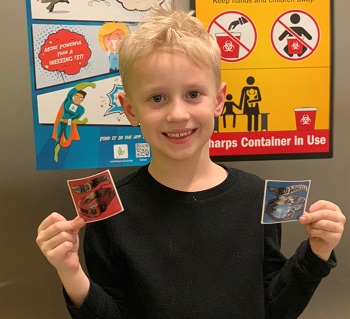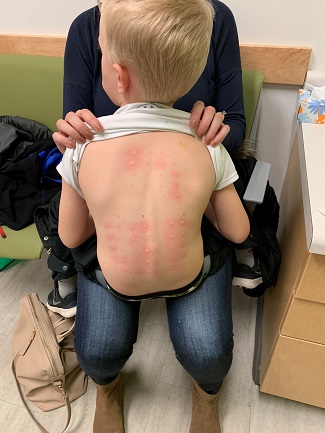Do you or someone in your family struggle with allergies? Have you thought about allergy treatment but aren’t sure about the whole allergy-shot process? Read this story from a Des Moines-area mom whose six-year-old son, Logan, is currently undergoing allergy treatment at Iowa ENT Center.
“Logan always seemed to be sick,” said his mom, Tracy. “His nose was always runny or stuffy. His eyes were red and itchy. And he was constantly sneezing.”
Tracy and her husband thought it could be allergies, so they started Logan on over-the-counter allergy meds. That lasted about a year.

When his symptoms still didn’t improve, Tracy took Logan to see Dr. Eytan Young, a pediatric ENT physician at Iowa ENT Center. He recommended allergy testing.
The testing process
“We made an appointment with their allergy specialists,” Tracy explained. “They went over all of the environmental (not food) allergies they test for. There are two main categories: grasses/trees/weeds and molds.
“They also explained how the testing works and what metrics they use,” Tracy continued. “And they went over the costs with our insurance in case immunotherapy was recommended based on Logan’s testing.”
For adults, allergy testing is done on the inside of the forearms. But because young kids don’t always have enough surface area there, the testing is sometimes done on their back.
“First, they wiped the area clean. Then they dipped a white plastic device with a lot of little prongs into the different allergens, which were all labeled, and they pressed those on his back,” Tracy said. “We were told not to touch the area for 15 minutes. Logan’s back started itching right away, though, so the allergy tech was kind enough to ‘rub’ around the areas to help alleviate the itching temporarily.
“After 15 minutes, they evaluated the results,” Tracy continued. “They looked for red/irritated welts, measuring each one that appeared. Each had to meet a certain size to be considered a true allergic reaction. Then they walked us through what triggered reactions. And they gave us a printout of the results.”

Before Tracy and Logan left, Dr. Young reviewed the results with them. “It turns out that Logan is allergic to almost everything,” Tracy joked. “Grasses, trees and weeds—as well as some molds and also cats.”
Based on Logan’s reactions, Dr. Young recommended immunotherapy. After considering the costs and what their insurance would cover, Tracy and her husband decided to go ahead with it. “From a financial perspective, the money you’ll spend on over-the-counter meds over the years ends up costing more in the long run. The hope is that after immunotherapy, he won’t need those meds," she said.
“And of course there’s the quality-of-life issue,” Tracy continued. “Logan’s allergies have made him really miserable, so we’re looking forward to the day when he doesn’t have to deal with that anymore.”
What is immunotherapy?
Immunotherapy involves incrementally increasing exposure to an allergen, usually via injections. Over time, the immune system becomes desensitized to the allergen. That reduces the frequency and severity of the allergic reaction. The duration of the therapy differs for every individual but generally ranges from three to five years.
The success rate of immunotherapy is very high. About 85% of immunotherapy patients reported that their allergy symptoms were either eliminated or significantly reduced.
At Iowa ENT Center, we train patients (or parents) to administer the shots themselves at home. That avoids unneeded trips to our office—saving them time and money.
Starting immunotherapy
When Logan started immunotherapy, he had a series of three in-office appointments—once a week for three weeks.
“At the first appointment, they administered the first set of shots. He gets two shots—one in each arm. At that point, Logan was pretty scared and did NOT want shots. The staff was really patient during the process, though. They had some tricks to help, and eventually it got easier,” said Tracy.
After the shots, the allergy staff monitored Logan for 30 minutes. “While we were waiting, they taught us how to administer the shots from home. That included sanitizing, drawing up the dose, administering the shot, discarding the needle and recording the dose,” Tracy said.
“They also covered what to do if there’s a severe reaction,” Tracy explained. “That’s where the EpiPen came in. We learned how that works and how to use it. My husband, Logan and I all had to demonstrate that we could do it on a tester.”
At the second appointment, Tracy and her husband administered the shots with the guidance of the allergy specialist. “It was really easy. Just a little nerve-wracking at first, because you know you’re being watched, and of course I didn’t want to cause pain for Logan. And I’ve never given a shot before. But after that first time, I was fine—and Logan said I did better than Dad!” said Tracy. Then their specialist reviewed everything with them again—and quizzed the couple to make sure they understood.
During the third appointment, they administered the shots themselves. “No instructions or help—to make sure we could do it ourselves at home. Then they quizzed us again. After that, they sent us home with a folder of information and a log sheet,” Tracy said.
Administering the shots at home
Now, Tracy and her husband give Logan his shots at home three times a week. “Surprisingly,” Tracy recalled, “the first couple of days at home were super easy! Logan cooperated and didn’t cry. Although the shots themselves start out really small in terms of dosage and gradually get bigger. Once they got bigger, he complained a little bit more. He’s always a little apprehensive, but for the most part he does just fine with them now. Ice cream helps, too!”
Each log sheet has space for recording 14 doses. “Once we fill up a log sheet, we go back to the office for a new set of vials and a new log sheet,” Tracy said. “When we’re in the office, we administer the shots there. Then we do the other two that week at home.”
Tracy keeps an EpiPen at home just in case Logan has a severe reaction. They also keep Benadryl on hand. “The whole EpiPen thing can be scary, but the chances of ever having to use it are slim to none,” said Tracy.
The long term
Logan’s immunotherapy process could take three to five years. “Year one is the most intense, doing shots three days a week. Then it tapers down from there,” Tracy explained.
Patients typically don’t notice any relief in their allergy symptoms until after the first year. So Logan still takes daily over-the-counter allergy medication.
“It’s definitely a long process,” said Tracy. “But Logan was really miserable with his allergies, so we know this will all be worth it in the long term. And everyone at Iowa ENT has been great—that’s made everything a lot easier.”
